【记录】记一次关于前端单元测试的全英文问卷调查( Survey: Automatically Generated Test Suites for JavaScript)
程序边界 2024-07-01 08:33:01 阅读 82
文章目录
OPENING STATEMENTBackgroundTask background: Fix the failing test casesBefore the task:
Task: Fix the failing test casesTask: Executable DocumentationBefore the task:
Bonus Opportunity: One more taskTask: Test Cases ClusteringRewardThank You!
原地址:Survey: Automatically Generated Test Suites for JavaScript
OPENING STATEMENT
You are being invited to participate in a research study that explores the effort developers put into understanding the content of the automatically generated test suite.
The purpose of this research study is to explore if different kinds of automatically generated test suites affect developers’ performance on program comprehension tasks. This study will take you approximately 30 minutes to complete. The anonymised data will be used for a master’s thesis project. We will be asking you to read multiple test suites, and answer related questions.
As with any online activity, the risk of a breach is always possible. To the best of our ability, your answers in this study will remain confidential. We will minimize any risks.
Until the end of the survey, the data is stored in Alchemer EU Data Center. Alchemer protects the respondents’ data and allows for its complete deletion. After the survey, the data is going to be deleted from Alchemer servers and transferred to an internal server at the Delft University of Technology. This means all data is protected by strict privacy laws. All the data are used for research purposes only; the data will not be, in any circumstances, sold or shared to third parties.The only directly identifiable PPI (Personally Identifiable Information) that will be collected in this survey is the email address you provide at the end of the survey. The purpose of collecting the email address is for reward distribution, and all email addresses will be deleted once the project is completed. The email address data will only be accessible to the research team.Only anonymised or aggregated information (questionnaire responses) will be made publicly available as part of the thesis project. All data will be uploaded to 4TU.ResearchData with public access for the purpose of FAIR (Findable, Accessible, Interoperable, Re-usable).
Your participation in this study is entirely voluntary and you can withdraw at any time. The email address data will be immediately deleted after the project ends, and the anonymous survey responses will be uploaded to 4TU.ResearchData with public access.
If you have any questions, please contact L.Lin-11@student.tudelft.nl. If you agree to this opening statement, you could participate in this study by clicking the button below and moving to the next page. Remember, your participation is completely voluntary, and you’re free to withdraw from the study at any time.
Thank you for considering participating in this research study.
Select your Answer Choices *
I consent to take part in this survey.
I do not want to take part in this survey.
Next
Background
What is your professional role? *(-- Please Select --)
Student (Bachelor or Master)Researcher (Ph.D candidate, Post-doctoral, or Professor)Software Developer
Years of experience *
< 1 year 1-2 years 3-6 years 6-10 years > 10 years
Software testing
JavaScript
| Space Cell | < 1 year | 1-2 years | 3-6 years | 6-10 years | > 10 years |
|---|---|---|---|---|---|
| Software testing | |||||
| JavaScript |

Have you ever used any automated test case generation tool? (If the answer is yes, please list the name of the tools) *
YesNo
Task background: Fix the failing test cases
Suppose you are a software developer on a challenging project with a vast and complex codebase. This project has an elaborate, automatically generated test suite, including many regression tests. These tests, designed to ensure that changes don’t break existing functionality, are vital to the project. Your task is to implement a new feature, which involves modifying some of the underlying logic in the codebase.
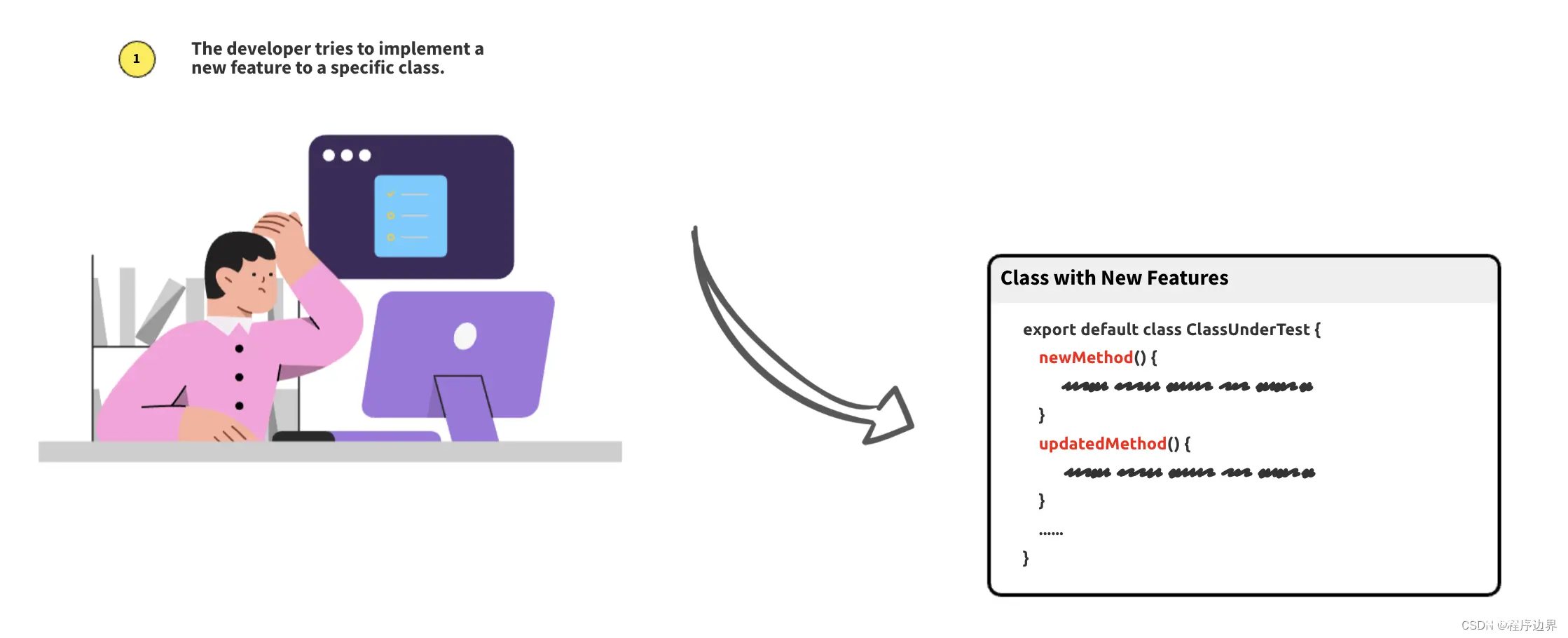
Following the project’s coding standards and best practices, you design and implement this change carefully. After finishing, you run the entire test suite. Your goal is to ensure that your changes haven’t inadvertently broken anything. Most of the tests pass. However, you find that some tests are failing.
Designers created these tests to check the behavior of the system’s part you’ve just modified. You changed this behavior intentionally to implement the new feature, so you know that the source code isn’t the issue. The problem is with the test suite—it hasn’t been updated to reflect the new expected behavior of the system.
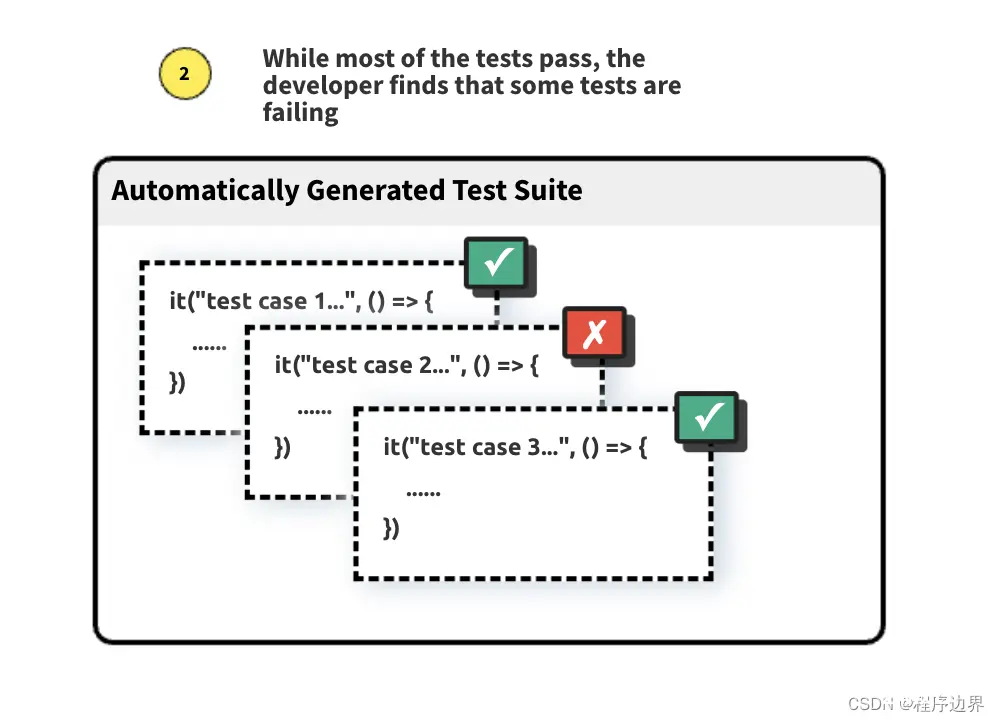
Instead of altering your source code to fit the old tests, which would mean failing to deliver the new feature, you meticulously examine the failing regression tests. You identify the assumptions these tests made about the system behavior that aren’t true anymore. Then, you fix these failing tests so that they accurately test the new behavior of the system.
Before the task:
We value your participation in this study and hope to gather the most accurate data possible to enhance the quality of our research. As part of this survey, we are recording the time you spend on each task.
We kindly request that once you start a task, you continue working on it without interruption until it’s completed. This measure will ensure the timing data we collect reflects the time actively spent on the task.
Please understand, this is not a test of speed, but a means for us to better understand the time dynamics of the tasks involved in our study.
We appreciate your understanding and cooperation. Thank you for your time and effort.
Task: Fix the failing test cases
As described in the previous page’s introduction, the bugs in this test code are caused by changes in the internal logic of certain methods in the class under test. The following image is a screenshot of the change history of the class under test. You can find the changes history here. These code changes resulted in the failure of some test cases in the test suite.
Your task is to find bugs in the test suite and answer questions.
You can find the class under test here.

Polygon.js
/**
* Class representing a Polygon.
*/
export default class Polygon {
/**
* Create a polygon.
*/
constructor() {
this.vertices = [];
}
/**
* Add a vertex to the polygon.
* @param {Object} vertex - The vertex to add.
* @throws {Error} If the vertex is not an object with numeric x and y properties.
*/
addVertex(vertex) {
if (typeof vertex.x !== "number" || typeof vertex.y !== "number") {
throw new Error(
"Vertex must be an object with numeric x and y properties"
);
}
this.vertices.push(vertex);
}
/**
* Remove a vertex from the polygon by its index.
* @param {number} index - The index of the vertex to remove.
* @throws {Error} If the index is out of bounds.
*/
removeVertex(index) {
if (index < 0 || index >= this.vertices.length) {
throw new Error("Index out of bounds");
}
this.vertices.splice(index, 1);
}
/**
* Calculate the perimeter of the polygon.
* @returns {number} The calculated perimeter.
*/
calculatePerimeter() {
let perimeter = 0;
for (let i = 0; i < this.vertices.length; i++) {
const v1 = this.vertices[i];
const v2 = this.vertices[(i + 1) % this.vertices.length];
const dx = v2.x - v1.x;
const dy = v2.y - v1.y;
perimeter += Math.sqrt(dx * dx + dy * dy);
}
return perimeter;
}
/**
* Calculate the area of the polygon.
* @returns {number} The calculated area.
*/
calculateArea() {
let area = 0;
for (let i = 0; i < this.vertices.length; i++) {
const v1 = this.vertices[i];
const v2 = this.vertices[(i + 1) % this.vertices.length];
area += v1.x * v2.y - v2.x * v1.y;
}
return Math.abs(area) / 2;
}
/**
* Check if a point is inside the polygon.
* @param {Object} point - The point to check.
* @returns {boolean} True if the point is inside the polygon, false otherwise.
*/
isPointInside(point) {
// This is a simple implementation based on ray casting algorithm and it assumes that the polygon is simple and convex
let inside = false;
for (
let i = 0, j = this.vertices.length - 1;
i < this.vertices.length;
j = i++
) {
const xi = this.vertices[i].x,
yi = this.vertices[i].y;
const xj = this.vertices[j].x,
yj = this.vertices[j].y;
const intersect =
yi > point.y !== yj > point.y &&
point.x < ((xj - xi) * (point.y - yi)) / (yj - yi) + xi;
if (intersect) inside = !inside;
}
return inside;
}
/**
* Translate the polygon by a vector.
* @param {Object} vector - The vector to translate the polygon.
* @throws {Error} If the vector is not an object with numeric x and y properties.
*/
translate(vector) {
if (typeof vector.x !== "number" || typeof vector.y !== "number") {
throw new Error(
"Vector must be an object with numeric x and y properties"
);
}
for (let vertex of this.vertices) {
vertex.x += vector.x;
vertex.y += vector.y;
}
}
/**
* Scale the polygon by a factor.
* @param {number} factor - The scale factor.
* @throws {Error} If the scale factor is not a number.
*/
scale(factor) {
if (typeof factor !== "number") {
throw new Error("Scale factor must be a number");
}
for (let vertex of this.vertices) {
vertex.x *= factor;
vertex.y *= factor;
}
}
/**
* Rotate the polygon by an angle.
* @param {number} angle - The rotation angle.
* @throws {Error} If the rotation angle is not a number.
*/
rotate(angle) {
if (typeof angle !== "number") {
throw new Error("Rotation angle must be a number");
}
const cos = Math.cos(angle);
const sin = Math.sin(angle);
for (let vertex of this.vertices) {
const x = vertex.x * cos - vertex.y * sin;
const y = vertex.x * sin + vertex.y * cos;
vertex.x = x;
vertex.y = y;
}
}
}
Polygon.test.js
import Polygon from "Polygon.js";
import chai from "chai";
import chaiAsPromised from "chai-as-promised";
chai.use(chaiAsPromised);
const expect = chai.expect;
describe("Polygon.js", () => {
context("Tests for multiple actions return Polygon object", () => {
it("calls rotate after addVertex and returns Polygon object", async () => {
const polygon = new Polygon();
const vertex = {
x: 128,
y: -7,
};
await polygon.addVertex(vertex);
const angle = 39;
await polygon.rotate(angle);
expect(JSON.parse(JSON.stringify(polygon))).to.deep.equal({
vertices: [
{
x: 40.876863046060585,
y: 121.49930891784368,
},
],
});
});
it("calls scale after addVertex and returns Polygon object", async () => {
const polygon = new Polygon();
const vertex = {
x: 113,
y: -704,
};
await polygon.addVertex(vertex);
const factor = 15;
await polygon.scale(factor);
expect(JSON.parse(JSON.stringify(polygon))).to.deep.equal({
vertices: [
{
x: 1695,
y: -10560,
},
],
});
});
it("calls rotate and returns Polygon object", async () => {
const polygon = new Polygon();
const vertex = {
x: -82,
y: -356,
};
await polygon.addVertex(vertex);
const angle = "tqp1-E";
await polygon.rotate(angle);
expect(JSON.parse(JSON.stringify(polygon))).to.deep.equal({
vertices: [
{
x: null,
y: null,
},
],
});
});
});
context("Tests for error handling of addVertex and removeVertex", () => {
it("throws an error with positive index", async () => {
const polygon = new Polygon();
const index = 254;
try {
await polygon.removeVertex(index);
} catch (e) {
expect(e).to.be.an("error");
}
});
it("throws an error with array vertex.x ", async () => {
const polygon = new Polygon();
const vertex = {
x: ["Ln0qFysBnz1"],
y: "RTurhxUamchFWW",
};
try {
await polygon.addVertex(vertex);
} catch (e) {
expect(e).to.be.an("error");
}
});
it("calls removeVertex after addVertex and returns Polygon object", async () => {
const polygon = new Polygon();
const vertex = {
y: -9.058398620535518,
x: -2.4308041085729872,
};
await polygon.addVertex(vertex);
const index = 0;
await polygon.removeVertex(index);
expect(JSON.parse(JSON.stringify(polygon))).to.deep.equal({
vertices: [],
});
});
it("throws an error with string factor", async () => {
const polygon = new Polygon();
const vertex = {
x: 282,
y: -46,
};
await polygon.addVertex(vertex);
const factor = "Nn_ESQK";
try {
await polygon.scale(factor);
} catch (e) {
expect(e).to.be.an("error");
}
});
it("throws an error with undefined vertex", async () => {
const polygon = new Polygon();
const vertex = undefined;
try {
await polygon.addVertex(vertex);
} catch (e) {
expect(e).to.be.an("error");
}
});
it("throws an error with null vertex", async () => {
const polygon = new Polygon();
const vertex = null;
try {
await polygon.addVertex(vertex);
} catch (e) {
expect(e).to.be.an("error");
}
});
it("throws an error with undefined point.y", async () => {
const polygon = new Polygon();
const vertex = {
x: 212,
y: -72,
};
await polygon.addVertex(vertex);
const point = undefined;
try {
await polygon.isPointInside(point);
} catch (e) {
expect(e).to.be.an("error");
}
});
});
context("Test for isPointInside", () => {
it("calls isPointInside and returns false", async () => {
const polygon = new Polygon();
const point = {
y: 90,
x: 198,
};
const returnValue = await polygon.isPointInside(point);
expect(returnValue).to.equal(false);
});
});
context("Tests for translate with different arguments", () => {
it("calls translate after addVertex and returns Polygon object", async () => {
const polygon = new Polygon();
const vertex = {
x: -94,
y: 82,
};
await polygon.addVertex(vertex);
const vector = {
x: 108,
y: -168,
};
await polygon.translate(vector);
expect(JSON.parse(JSON.stringify(polygon))).to.deep.equal({
vertices: [
{
x: -202,
y: 250,
},
],
});
});
it("throws an error with string vector.x", async () => {
const polygon = new Polygon();
const vector = {
x: "zwxHQ",
y: 916,
};
try {
await polygon.translate(vector);
} catch (e) {
expect(e).to.be.an("error");
}
});
it("calls translate and returns Polygon object", async () => {
const polygon = new Polygon();
const vector = {
x: -287,
y: -47,
};
await polygon.translate(vector);
expect(JSON.parse(JSON.stringify(polygon))).to.deep.equal({
vertices: [],
});
});
});
context("Test for calculatePerimeter", () => {
it("calls calculatePerimeter after addVertex and returns positive", async () => {
const polygon = new Polygon();
const vertex1 = {
x: 125,
y: -7,
};
await polygon.addVertex(vertex1);
const returnValue = await polygon.calculatePerimeter();
expect(returnValue).to.equal(0);
});
});
context("Tests for calculateArea", () => {
it("throws an error with vertices.length=2", async () => {
const polygon = new Polygon();
const vector1 = {
x: 459,
y: -387,
};
await polygon.addVertex(vector1);
const vector2 = {
x: 361,
y: 23,
};
await polygon.addVertex(vector2);
try {
const returnValue = await polygon.calculateArea();
expect.fail();
} catch (e) {
expect(e).to.be.an("error");
}
});
it("throws an error with vertices.length=1", async () => {
const polygon = new Polygon();
const vertex1 = {
x: 23,
y: 499,
};
await polygon.addVertex(vertex1);
try {
const returnValue = await polygon.calculateArea();
expect.fail();
} catch (e) {
expect(e).to.be.an("error");
}
});
});
});
Please select the test cases that you believe will fail. (The number of the failing test cases is no more than 5) *
calls rotate after addVertex and returns Polygon objectcalls scale after addVertex and returns Polygon objectcalls rotate and returns Polygon objectthrows an error with positive indexthrows an error with array vertex.xcalls removeVertex after addVertex and returns Polygon objectthrows an error with string factorthrows an error with undefined vertexthrows an error with null vertexthrows an error with undefined point.ycalls isPointInside and returns falsecalls translate after addVertex and returns Polygon objectthrows an error with string vector.xcalls translate and returns Polygon objectcalls calculatePerimeter after addVertex and returns positivethrows an error with vertices.length=2throws an error with vertices.length=1
For the test cases that you believe would fail, please provide the line number(s) or range of lines that you suspect may contain a bug, and explain what the bug is.
test case name what the bug is
Bug1
Bug2
Bug3
Bug4
Bug5
| Space Cell | test case name | what the bug is |
|---|---|---|
| Bug1 | ||
| Bug2 | ||
| Bug3 | ||
| Bug4 | ||
| Bug5 |

During the process of identifying bugs in the test cases, which parts of the test suite do you think would be helpful to you? *
Test suite structure or layoutTest case description or purposeInput data and conditionsExpected results (assertions)Executed steps and actions in test caseCode highlightOther reason *
Task: Executable Documentation
Suppose you are a new developer who is dealing with legacy codebase, one of the main challenges you face is understanding the existing system, which can be complex and convoluted. To make matters worse, the original developers are no longer available to address queries, and the documentation provided is both poor and outdated.

Despite these obstacles, there is a silver lining: the system boasts a suite of automatically generated unit tests for the class you are currently investigating. Remarkably, all the test cases in the suite have passed successfully.
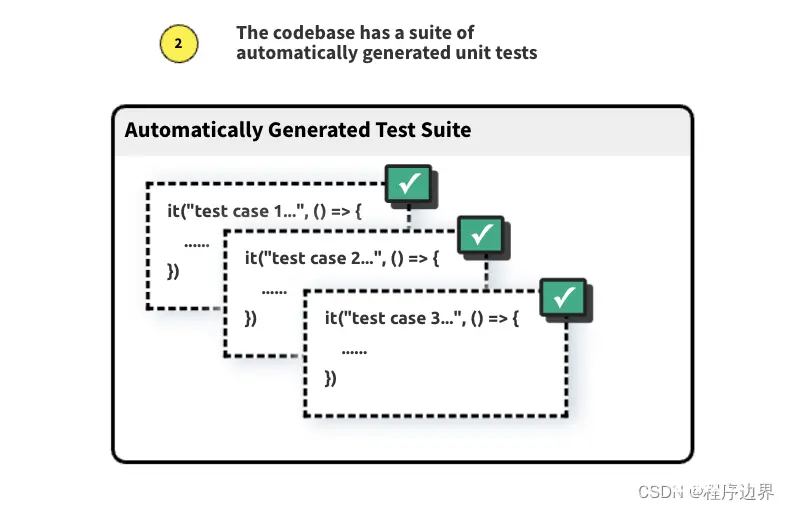
Recognizing the value of these automatically generated unit tests, your objective is to dive into the content of this test suite. Your aim is to extract meaningful insights regarding the intended behavior and expected functionality of the CUT (class under test). By analyzing the test suite, you hope to gain a clearer understanding of how the CUT is supposed to do and what the expected outcome is under various circumstances.
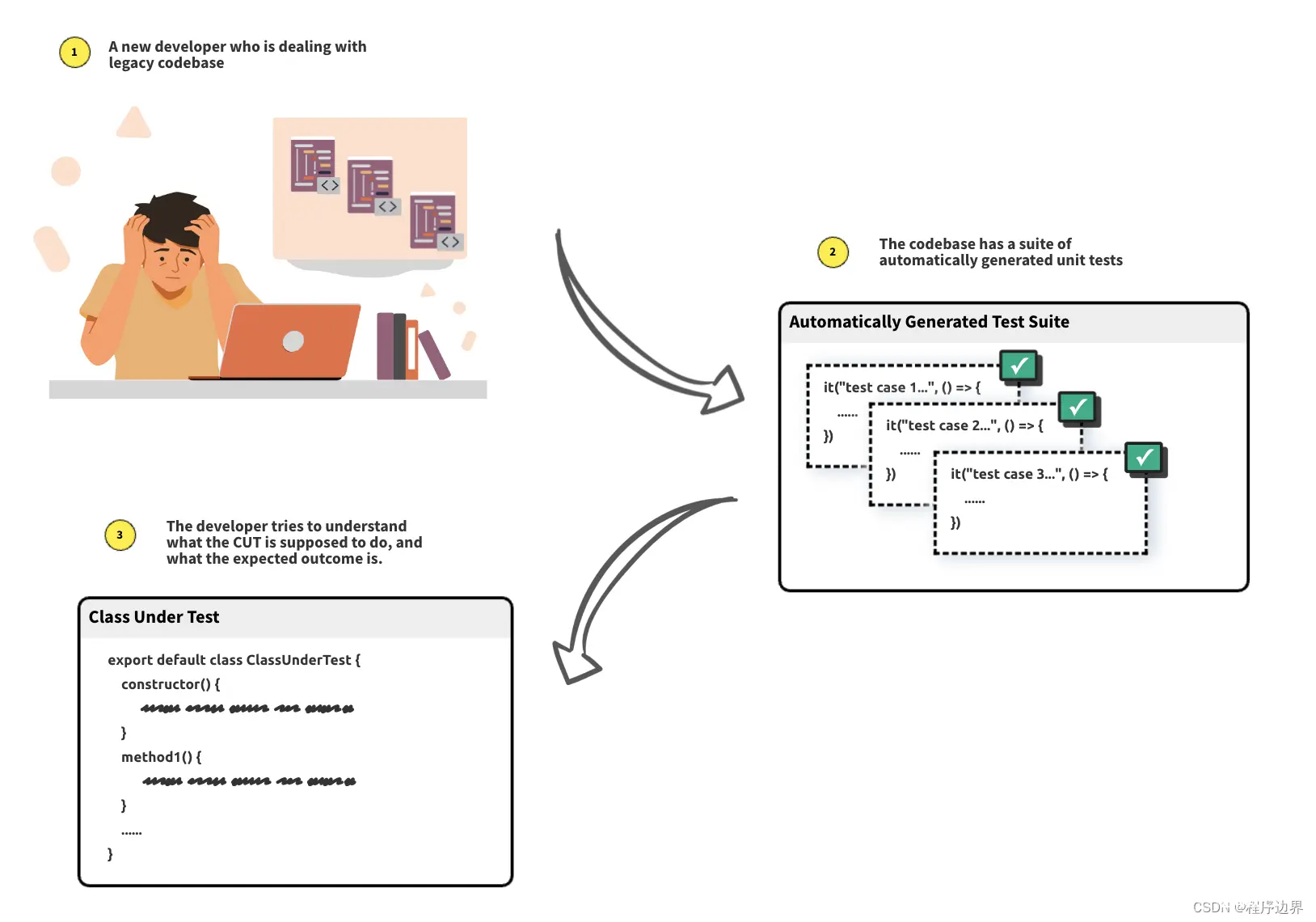
Before the task:
We value your participation in this study and hope to gather the most accurate data possible to enhance the quality of our research. As part of this survey, we are recording the time you spend on each task.
We kindly request that once you start a task, you continue working on it without interruption until it’s completed. This measure will ensure the timing data we collect reflects the time actively spent on the task.
Please understand, this is not a test of speed, but a means for us to better understand the time dynamics of the tasks involved in our study.
We appreciate your understanding and cooperation. Thank you for your time and effort.
Task: Executable Documentation
In this task, you will first be asked to carefully read a test suite that we have prepared.
This test suite contains valuable information necessary to answer the subsequent questions. It is important to understand the contents thoroughly before moving forward as the questions are closely related to the provided material.
Here the the automatically generated test suite for the CUT.
describe("AnonymousClass", () => {
it("throws an error when itemName is null", async () => {
const anonymousInstance = new AnonymousClass();
const itemName = null;
const quantity = 6;
try {
await anonymousInstance.removeItem(itemName, quantity);
} catch (e) {
expect(e).to.be.an("error");
}
});
it("throws an error when discount is boolean", async () => {
const anonymousInstance = new AnonymousClass();
const discount = false;
try {
await anonymousInstance.applyDiscount(discount);
} catch (e) {
expect(e).to.be.an("error");
}
});
it("throws an error when itemName is boolean and quantity is negative", async () => {
const anonymousInstance = new AnonymousClass();
const itemName = false;
const quantity = -4.463676586368846;
try {
await anonymousInstance.removeItem(itemName, quantity);
} catch (e) {
expect(e).to.be.an("error");
}
});
it("calls getTotalPrice and returns 0", async () => {
const anonymousInstance = new AnonymousClass();
const returnValue = await anonymousInstance.getTotalPrice();
expect(returnValue).to.equal(0);
});
it("calls getItem and returns undefined", async () => {
const anonymousInstance = new AnonymousClass();
const itemName = "f7TRlPDk8rN_1QhwDGbjrD0RS";
const returnValue = await anonymousInstance.getItem(itemName);
expect(returnValue).to.equal(undefined);
});
it("throws an error when itemName is boolean", async () => {
const anonymousInstance = new AnonymousClass();
const itemName = true;
const quantity = 5;
try {
await anonymousInstance.removeItem(itemName, quantity);
} catch (e) {
expect(e).to.be.an("error");
}
});
it("throws an error when itemName is function", async () => {
const anonymousInstance = new AnonymousClass();
const itemName = () => { };
try {
const returnValue = await anonymousInstance.findItem(itemName);
} catch (e) {
expect(e).to.be.an("error");
}
});
it("throws an error when itemName is positve, quantity is string, and price is string", async () => {
const anonymousInstance = new AnonymousClass();
const itemName = 9;
const quantity = " ";
const price = "QAvFGJhRb7V89b";
try {
await anonymousInstance.addItem(itemName, quantity, price);
} catch (e) {
expect(e).to.be.an("error");
}
});
it("calls getItems and returns empty array", async () => {
const anonymousInstance = new AnonymousClass();
const returnValue = await anonymousInstance.getItems();
expect(JSON.parse(JSON.stringify(returnValue))).to.deep.equal([]);
});
it("throws an error when itemName is array", async () => {
const anonymousInstance = new AnonymousClass();
const itemName = ["FLxn4T3hFmo_pdwa"];
try {
const returnValue = await anonymousInstance.getItem(itemName);
} catch (e) {
expect(e).to.be.an("error");
}
});
it("calls getTotalPrice and returns 0", async () => {
const anonymousInstance = new AnonymousClass();
const returnValue = await anonymousInstance.getTotalPrice();
expect(returnValue).to.equal(0);
});
it("calls clearCart and return an object", async () => {
const anonymousInstance = new AnonymousClass();
await anonymousInstance.clearCart();
expect(JSON.parse(JSON.stringify(anonymousInstance))).to.deep.equal({
items: [],
});
});
it("throws an error when itemName is number", async () => {
const anonymousInstance = new AnonymousClass();
const itemName = 2;
const quantity = 1;
const price = 3;
try {
await anonymousInstance.addItem(itemName, quantity, price);
} catch (e) {
expect(e).to.be.an("error");
}
});
it("throws an error when quantity is string and price is negative", async () => {
const anonymousInstance = new AnonymousClass();
const itemName = "kzExxpeYXazeWf9mt1jS-lYsz_VLg";
const quantity = "3bBWPprqh6-UQhXbeB3JDd3ZjZlxM";
const price = -9;
try {
await anonymousInstance.addItem(itemName, quantity, price);
} catch (e) {
expect(e).to.be.an("error");
}
});
it("calls getItemCount after clearCart and returns 0", async () => {
const anonymousInstance = new AnonymousClass();
await anonymousInstance.clearCart();
const returnValue = await anonymousInstance.getItemCount();
expect(returnValue).to.equal(0);
});
it("throws an error when price is negative", async () => {
const anonymousInstance = new AnonymousClass();
const itemName = "eyAo";
const quantity = 3;
const price = -5;
try {
const returnValue = await anonymousInstance.validateInput(
itemName,
quantity,
price
);
} catch (e) {
expect(e).to.be.an("error");
}
});
it("calls findItem after addItem and returns undefined", async () => {
const anonymousInstance = new AnonymousClass();
const itemName1 = " ";
const quantity = 8;
const price = 3;
await anonymousInstance.addItem(itemName1, quantity, price);
const itemName2 = "wzjojDV1";
const returnValue2 = await anonymousInstance.findItem(itemName2);
expect(returnValue2).to.equal(undefined);
});
it("throws an error when existingItem is null", async () => {
const anonymousInstance = new AnonymousClass();
const itemName = "1q_r-l5U";
const quantity = 9;
try {
await anonymousInstance.removeItem(itemName, quantity);
} catch (e) {
expect(e).to.be.an("error");
}
});
it("calls applyDiscount and returns an object", async () => {
const anonymousInstance = new AnonymousClass();
const discount = 0.8899157137301756;
await anonymousInstance.applyDiscount(discount);
expect(JSON.parse(JSON.stringify(anonymousInstance))).to.deep.equal({
items: [],
});
});
it("throws an error when itemName is boolean, quantity is negative, and price is string", async () => {
const anonymousInstance = new AnonymousClass();
const itemName = true;
const quantity = -5;
const price = "rLq8PuPerUGBxu-Eun0OqMbNU";
try {
await anonymousInstance.addItem(itemName, quantity, price);
} catch (e) {
expect(e).to.be.an("error");
}
});
it("calls getItem after addItem and returns undefined", async () => {
const anonymousInstance = new AnonymousClass();
const itemName1 = "pvl3A6SYojiN3mtY-cRXQfm5!93";
const quantity = 1;
const price = 9.956023066500322;
await anonymousInstance.addItem(itemName1, quantity, price);
const itemName2 = "VNVsx7";
const returnValue = await anonymousInstance.getItem(itemName2);
expect(returnValue).to.equal(undefined);
});
});
Based on the functionalities demonstrated in the provided test cases, can you infer an approximate name for the AnonymousClass ?
(A name that conveys the class’s general purpose or a specific class name that might be used in a real codebase) *
Class Name [ _______________________ ]
Based on your understanding from the test suite, can you identify any specific inputs or scenarios where the removeItem and addItem might throw an exception? Select the answer that you think is appropriate.
removeItem *
Removing an item when the item name is null.Removing an item with a quantity greater than the existing quantity in the cart.Removing an item with a negative quantity.Removing an item that does not exist in the shopping cart.Removing an item when the quantity is a postive number.Removing an item from an empty shopping cart.Removing an item when the itemName is a number.
addItem *
Adding an item when the item name is an empty string.Adding an item when the quantity is not a positive number.Adding an item when the price is a string value.Adding an item when the item already exists in the shopping cartAdding an item when the price is a floating point number.Adding an item when the both price and quantity are positive numbers.
Here we provide the source code of the addItem and removeItem.
Please read the following code and answer the related questions.
addItem(itemName, quantity, price) {
this.validateInput(itemName, quantity, price);
const existingItem = this.findItem(itemName);
if (existingItem) {
existingItem.quantity += quantity;
} else {
this.items.push(new ShoppingCartItem(itemName, quantity, price));
}
return this;
}
removeItem(itemName, quantity) {
this.validateInput(itemName, quantity, 0);
const existingItem = this.findItem(itemName);
if (!existingItem) {
throw new Error("Item does not exist");
}
if (existingItem.quantity < quantity) {
throw new Error("Invalid quantity");
} else if (existingItem.quantity === quantity) {
this.items = this.items.filter((item) => item.productName !== itemName);
} else {
existingItem.quantity -= quantity;
}
return this;
}
validateInput(itemName, quantity, price) {
const errors = [];
if (typeof itemName !== "string" || itemName.length === 0) {
errors.push("Invalid item name");
}
if (typeof quantity !== "number" || quantity < 0) {
errors.push("Invalid quantity");
}
if (typeof price !== "number" || price < 0) {
errors.push("Invalid price");
}
if (errors.length > 0) {
throw new Error(errors.join(", "));
}
}
findItem(itemName) {
if (typeof itemName !== "string" || itemName.length === 0) {
throw new Error("Invalid item name");
}
return this.items.find((item) => item.productName === itemName);
}
After reading the source code, you may have a complete understanding of the inputs, outputs, and operational logic of these two methods. Do you agree that *
the test suite provided earlier effectively serves as “live” documentation that helps you understand these two methods better.
Strongly disagreeDisagreeNeutralAgreeStrongly agreeNot applicable
Now, let’s expand the scope to the entire class under test. Do you agree that *
it was easy for you to understand the functionality and design of the AnonymousClass from the test suite
Strongly disagreeDisagreeNeutralAgreeStrongly agreeNot applicable
you were confident in your understanding of the AnonymousClass based on the test suite
Strongly disagreeDisagreeNeutralAgreeStrongly agreeNot applicable
Did you encounter any difficulties while reading the test cases, or do you think some of the content in the test cases was helpful to you? *
Selection: *
encounter some difficultiesthe test suite is helpful
Please elaborate on your answer *
Bonus Opportunity: One more task
We value your insights and would like to offer you an optional opportunity to earn additional rewards. By choosing to complete one more task following, you will receive extra reward.
Please indicate your interest:
I would like to participate and earn bonus.I would like to skip this opportunity.
Task: Test Cases Clustering
In this task, we will provide you with a set of automatically generated test cases. Your task is to review these test cases and group them into different categories. This process is known as ‘test case clustering’.
You need to categorize these test cases based on your own idea, such as the functionality they test, the methods they use, the input data they require, or any other criteria that make sense to you. We encourage you to create clusters that help you understand the test suite and the underlying code better.
After you finish the clustering, we will ask you to provide a brief justification for your categorization. This is to help us understand your thought process and the logic behind your decisions.
Here are all the test cases you will use in this task, you can go to the question part first and review the code as you need.
Find the class under test here.
it("TC1: throws an error when itemName is null", async () => {
const shoppingCart = new ShoppingCart();
const itemName = null;
const quantity = 6;
try {
await shoppingCart.removeItem(itemName, quantity);
} catch (e) {
expect(e).to.be.an("error");
}
});
it("TC2: throws an error when discount is boolean", async () => {
const shoppingCart = new ShoppingCart();
const discount = false;
try {
await shoppingCart.applyDiscount(discount);
} catch (e) {
expect(e).to.be.an("error");
}
});
it("TC3: throws an error when itemName is boolean and quantity is negative", async () => {
const shoppingCart = new ShoppingCart();
const itemName = false;
const quantity = -4.463676586368846;
try {
await shoppingCart.removeItem(itemName, quantity);
} catch (e) {
expect(e).to.be.an("error");
}
});
it("TC4: calls getTotalPrice and returns 0", async () => {
const shoppingCart = new ShoppingCart();
const returnValue = await shoppingCart.getTotalPrice();
expect(returnValue).to.equal(0);
});
it("TC5: calls getItem and returns undefined", async () => {
const shoppingCart = new ShoppingCart();
const itemName = "f7TRlPDk8rN_1QhwDGbjrD0RS";
const returnValue = await shoppingCart.getItem(itemName);
expect(returnValue).to.equal(undefined);
});
it("TC6: throws an error when itemName is boolean", async () => {
const shoppingCart = new ShoppingCart();
const itemName = true;
const quantity = 5;
try {
await shoppingCart.removeItem(itemName, quantity);
} catch (e) {
expect(e).to.be.an("error");
}
});
it("TC7: throws an error when itemName is function", async () => {
const shoppingCart = new ShoppingCart();
const itemName = () => { };
try {
const returnValue = await shoppingCart.findItem(itemName);
} catch (e) {
expect(e).to.be.an("error");
}
});
it("TC8: throws an error when itemName is positve, quantity is string, and price is string", async () => {
const shoppingCart = new ShoppingCart();
const itemName = 9;
const quantity = " ";
const price = "QAvFGJhRb7V89b";
try {
await shoppingCart.addItem(itemName, quantity, price);
} catch (e) {
expect(e).to.be.an("error");
}
});
it("TC9: calls getItems and returns empty array", async () => {
const shoppingCart = new ShoppingCart();
const returnValue = await shoppingCart.getItems();
expect(JSON.parse(JSON.stringify(returnValue))).to.deep.equal([]);
});
it("TC10: throws an error when itemName is array", async () => {
const shoppingCart = new ShoppingCart();
const itemName = ["FLxn4T3hFmo_pdwa"];
try {
const returnValue = await shoppingCart.getItem(itemName);
} catch (e) {
expect(e).to.be.an("error");
}
});
it("TC11: calls getTotalPrice and returns 0", async () => {
const shoppingCart = new ShoppingCart();
const returnValue = await shoppingCart.getTotalPrice();
expect(returnValue).to.equal(0);
});
it("TC12: calls clearCart and return an object", async () => {
const shoppingCart = new ShoppingCart();
await shoppingCart.clearCart();
expect(JSON.parse(JSON.stringify(shoppingCart))).to.deep.equal({
items: [],
});
});
it("TC13: throws an error when itemName is number", async () => {
const shoppingCart = new ShoppingCart();
const itemName = 2;
const quantity = 1;
const price = 3;
try {
await shoppingCart.addItem(itemName, quantity, price);
} catch (e) {
expect(e).to.be.an("error");
}
});
it("TC14: throws an error when quantity is string and price is negative", async () => {
const shoppingCart = new ShoppingCart();
const itemName = "kzExxpeYXazeWf9mt1jS-lYsz_VLg";
const quantity = "3bBWPprqh6-UQhXbeB3JDd3ZjZlxM";
const price = -9;
try {
await shoppingCart.addItem(itemName, quantity, price);
} catch (e) {
expect(e).to.be.an("error");
}
});
it("TC15: calls getItemCount after clearCart and returns 0", async () => {
const shoppingCart = new ShoppingCart();
await shoppingCart.clearCart();
const returnValue = await shoppingCart.getItemCount();
expect(returnValue).to.equal(0);
});
it("TC16: throws an error when price is negative", async () => {
const shoppingCart = new ShoppingCart();
const itemName = "eyAo";
const quantity = 3;
const price = -5;
try {
const returnValue = await shoppingCart.validateInput(
itemName,
quantity,
price
);
} catch (e) {
expect(e).to.be.an("error");
}
});
it("TC17: calls findItem after addItem and returns undefined", async () => {
const shoppingCart = new ShoppingCart();
const itemName1 = " ";
const quantity = 8;
const price = 3;
await shoppingCart.addItem(itemName1, quantity, price);
const itemName2 = "wzjojDV1";
const returnValue2 = await shoppingCart.findItem(itemName2);
expect(returnValue2).to.equal(undefined);
});
it("TC18: throws an error when existingItem is null", async () => {
const shoppingCart = new ShoppingCart();
const itemName = "1q_r-l5U";
const quantity = 9;
try {
await shoppingCart.removeItem(itemName, quantity);
} catch (e) {
expect(e).to.be.an("error");
}
});
it("TC19: calls applyDiscount and returns an object", async () => {
const shoppingCart = new ShoppingCart();
const discount = 0.8899157137301756;
await shoppingCart.applyDiscount(discount);
expect(JSON.parse(JSON.stringify(shoppingCart))).to.deep.equal({
items: [],
});
});
it("TC20: throws an error when itemName is boolean, quantity is negative, and price is string", async () => {
const shoppingCart = new ShoppingCart();
const itemName = true;
const quantity = -5;
const price = "rLq8PuPerUGBxu-Eun0OqMbNU";
try {
await shoppingCart.addItem(itemName, quantity, price);
} catch (e) {
expect(e).to.be.an("error");
}
});
it("TC21: calls getItem after addItem and returns undefined", async () => {
const shoppingCart = new ShoppingCart();
const itemName1 = "pvl3A6SYojiN3mtY-cRXQfm5!93";
const quantity = 1;
const price = 9.956023066500322;
await shoppingCart.addItem(itemName1, quantity, price);
const itemName2 = "VNVsx7";
const returnValue = await shoppingCart.getItem(itemName2);
expect(returnValue).to.equal(undefined);
});
Please classify/cluster/group the test cases into any number of categories based on any rules you desire.
Please remember, there are no ‘right’ or ‘wrong’ answers in this task. We are interested in your personal approach to understanding test cases and how you perceive their organization can aid in comprehension.
(tip: you can review the categoried image by zooming in or out on the webpage, the image retains its original resolution) *
Drag items from below into the appropriate categories.
[____________________]
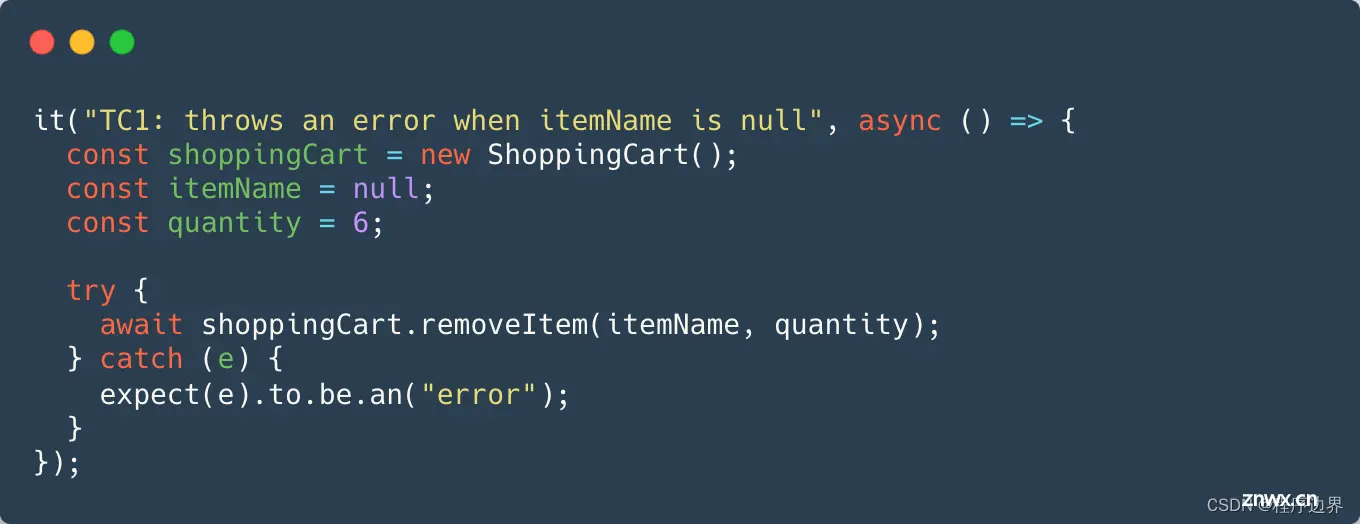

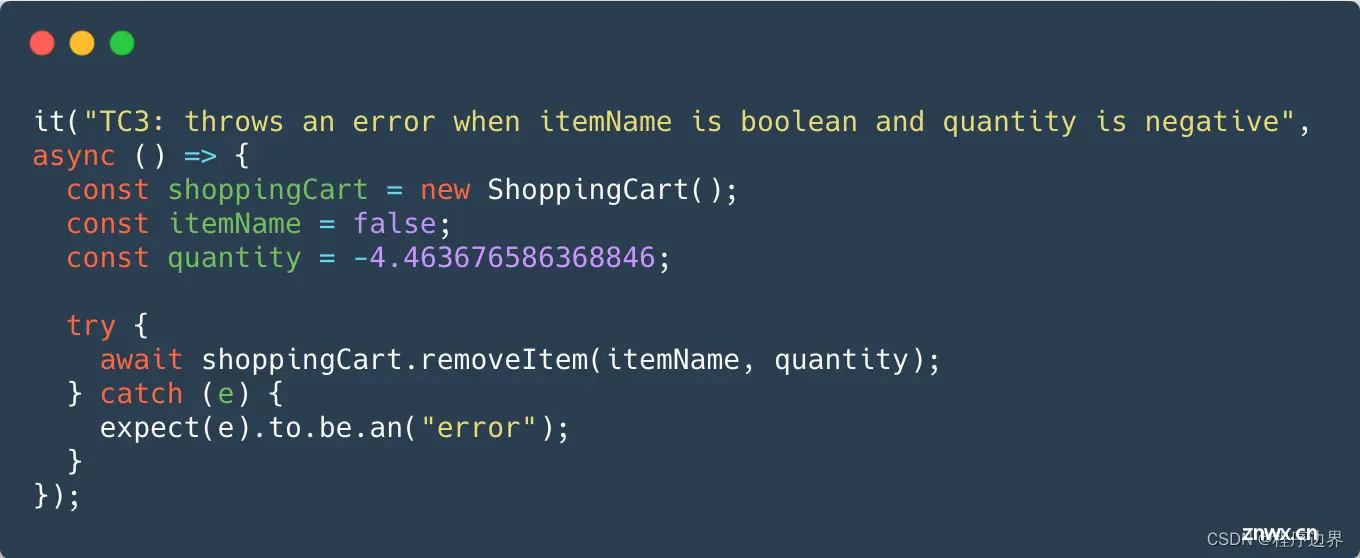



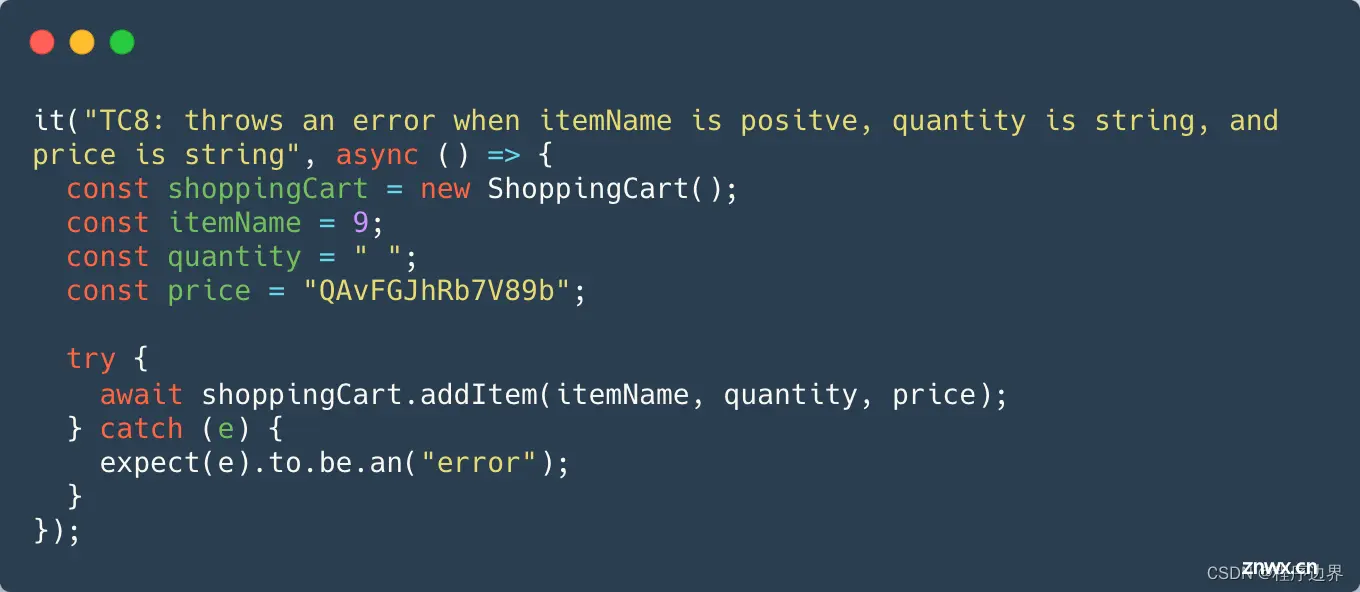

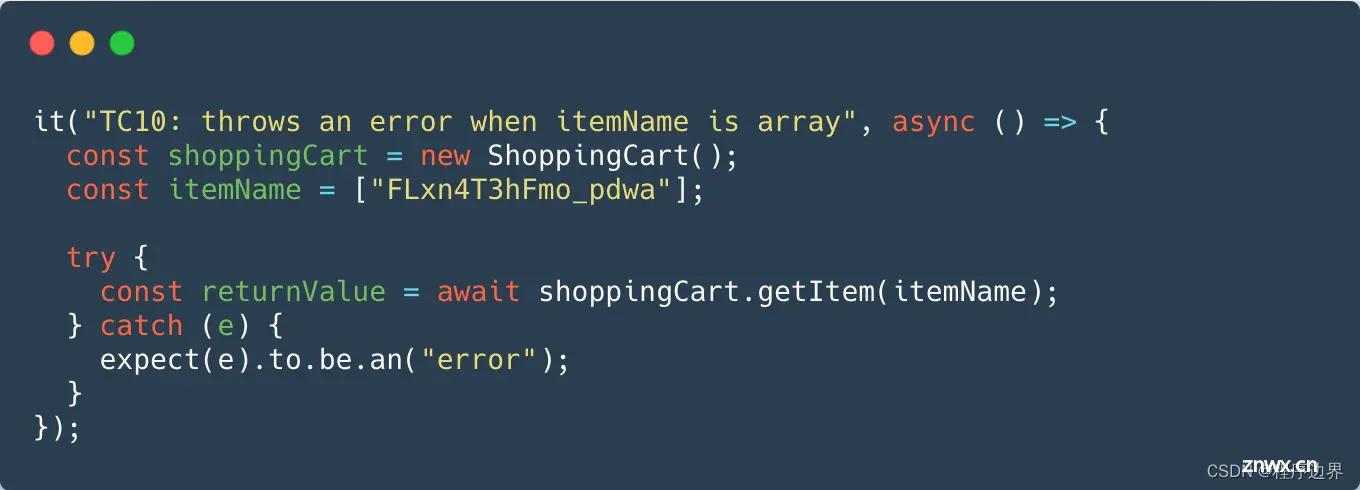



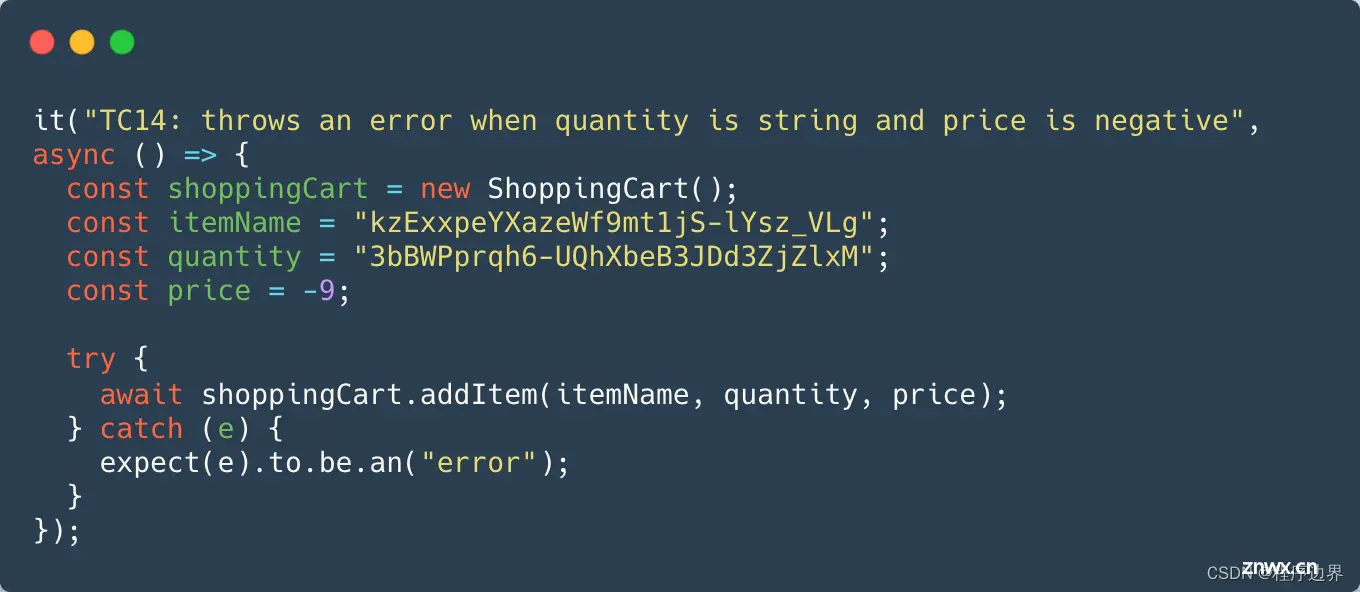

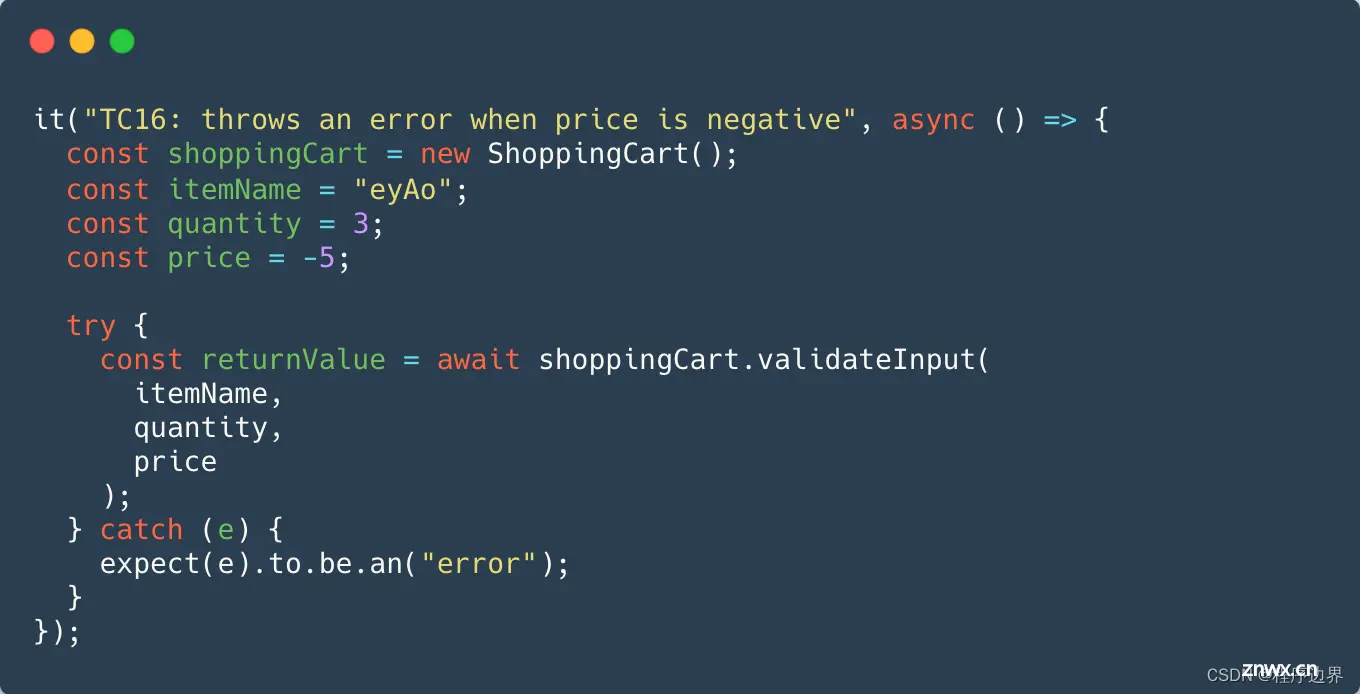

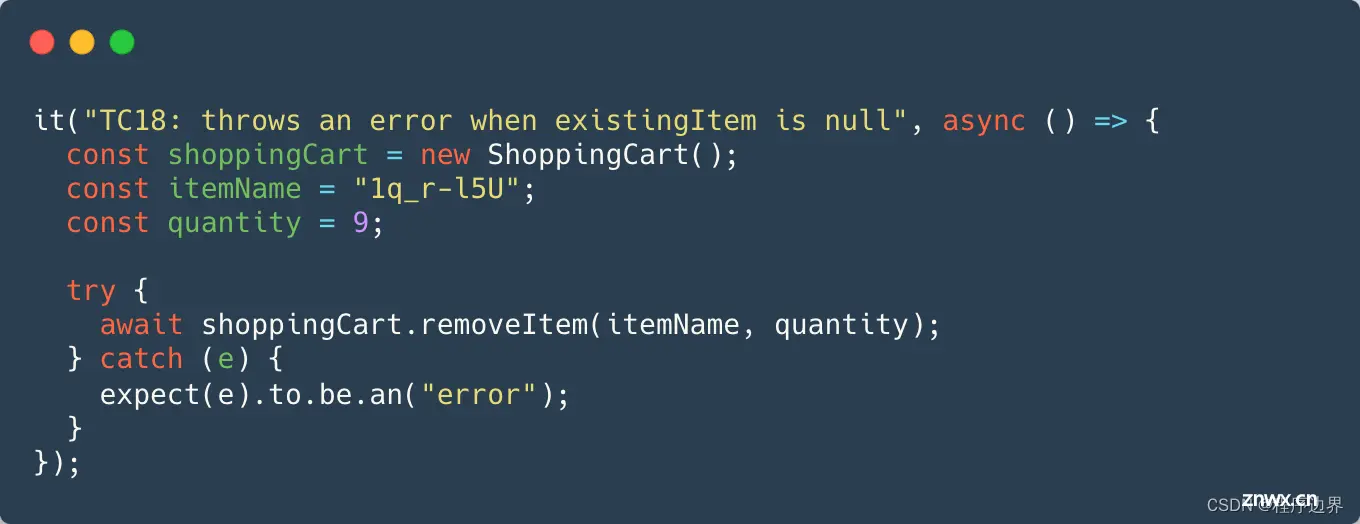


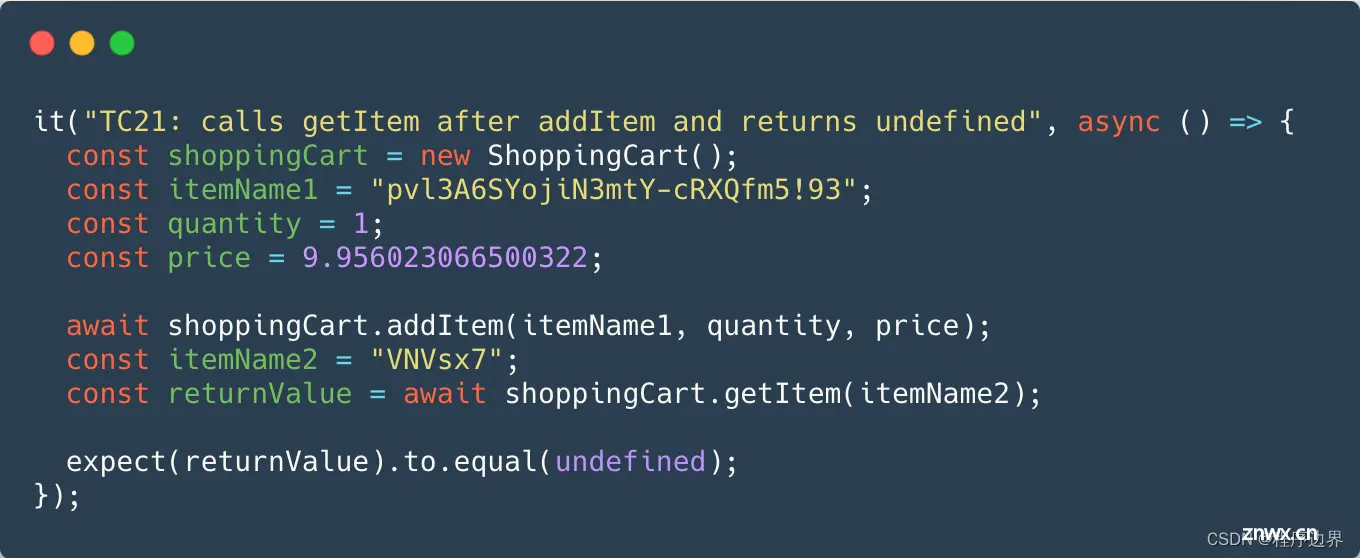
Drop an item here to create a new category
[____________________]
16. Please provide a simple explanation of your rules of categorizing. *
Reward
Please write down your email for rewarding. If you do not receive your reward in 3 working days, please send a email to me (L.Lin-11@student.tudelft.nl) *
Thank You!
Thank you for taking our survey. Your response is very important to us.
测试需要分为基础测试和功能测试,基础测试保证程序运行下去,功能测试保证程序结果是理想的
摘录自一次问卷调查,为防原地址失效特记录于此,英文好的小伙伴可以过一遍,相信对前端单元测试的理解会有所帮助
over。。。
上一篇: Vue
下一篇: metaRTC8.0,一个全新架构的webRTC SDK库
本文标签
【记录】记一次关于前端单元测试的全英文问卷调查( Survey: Automatically Generated Test Suites for JavaScript)
声明
本文内容仅代表作者观点,或转载于其他网站,本站不以此文作为商业用途
如有涉及侵权,请联系本站进行删除
转载本站原创文章,请注明来源及作者。